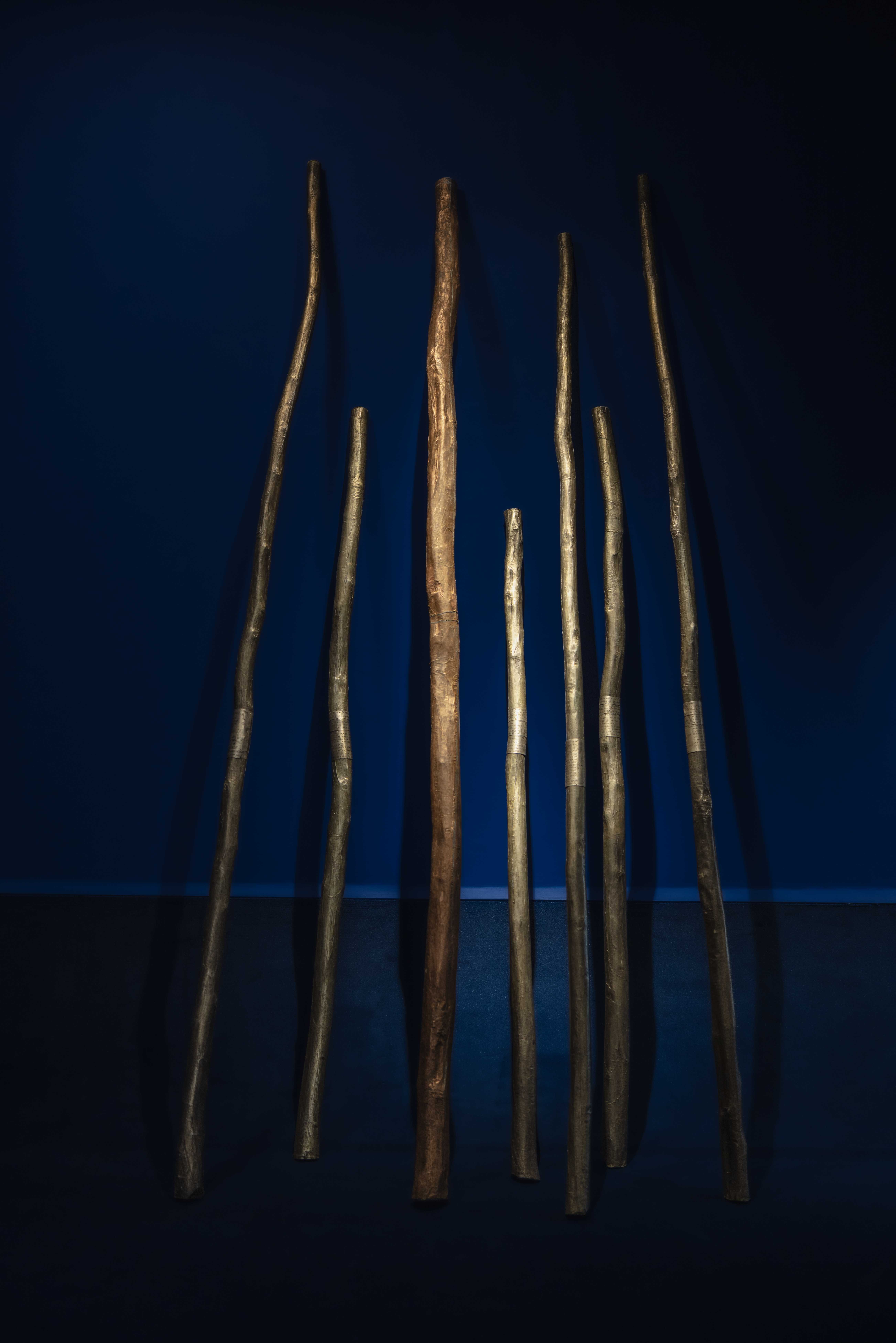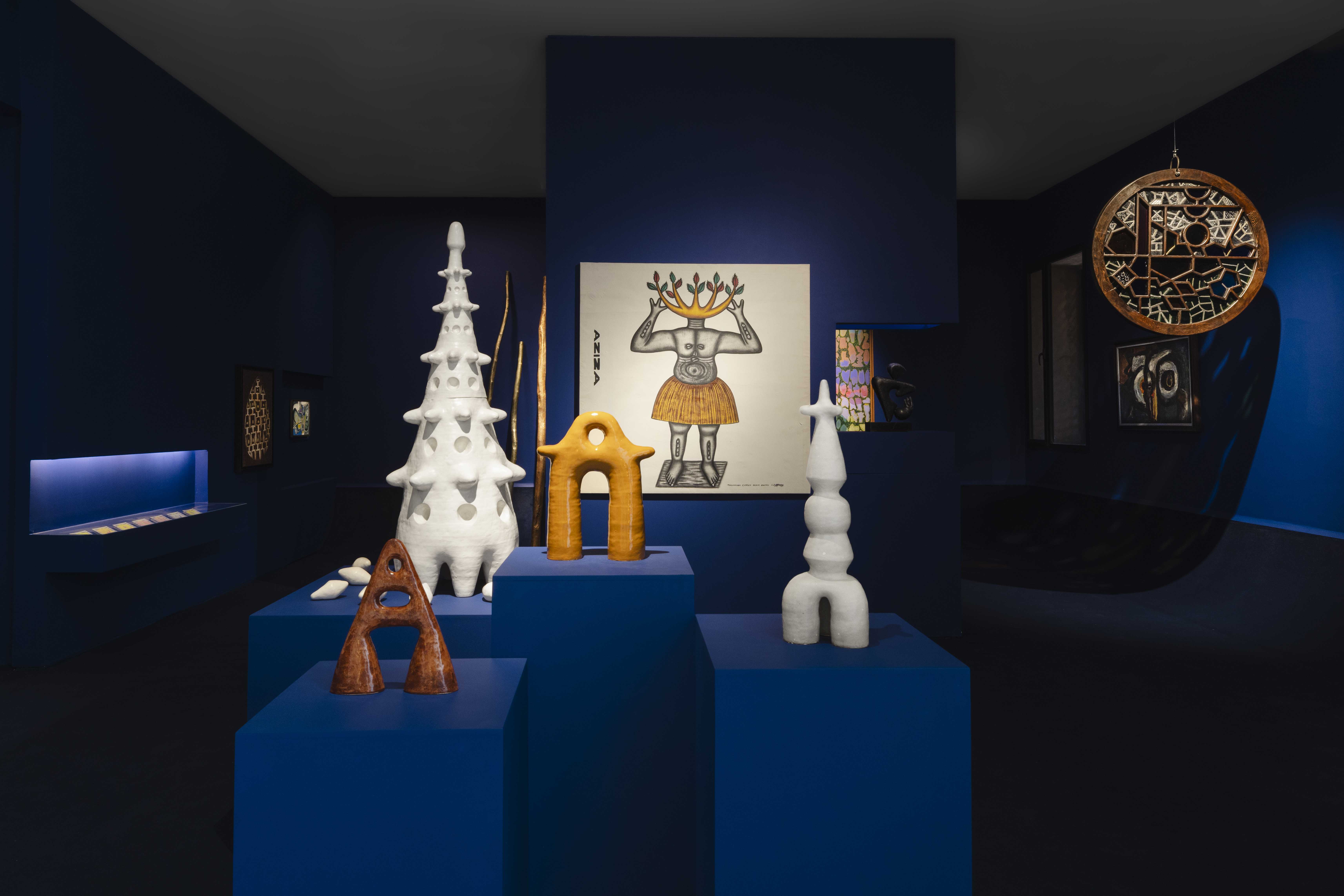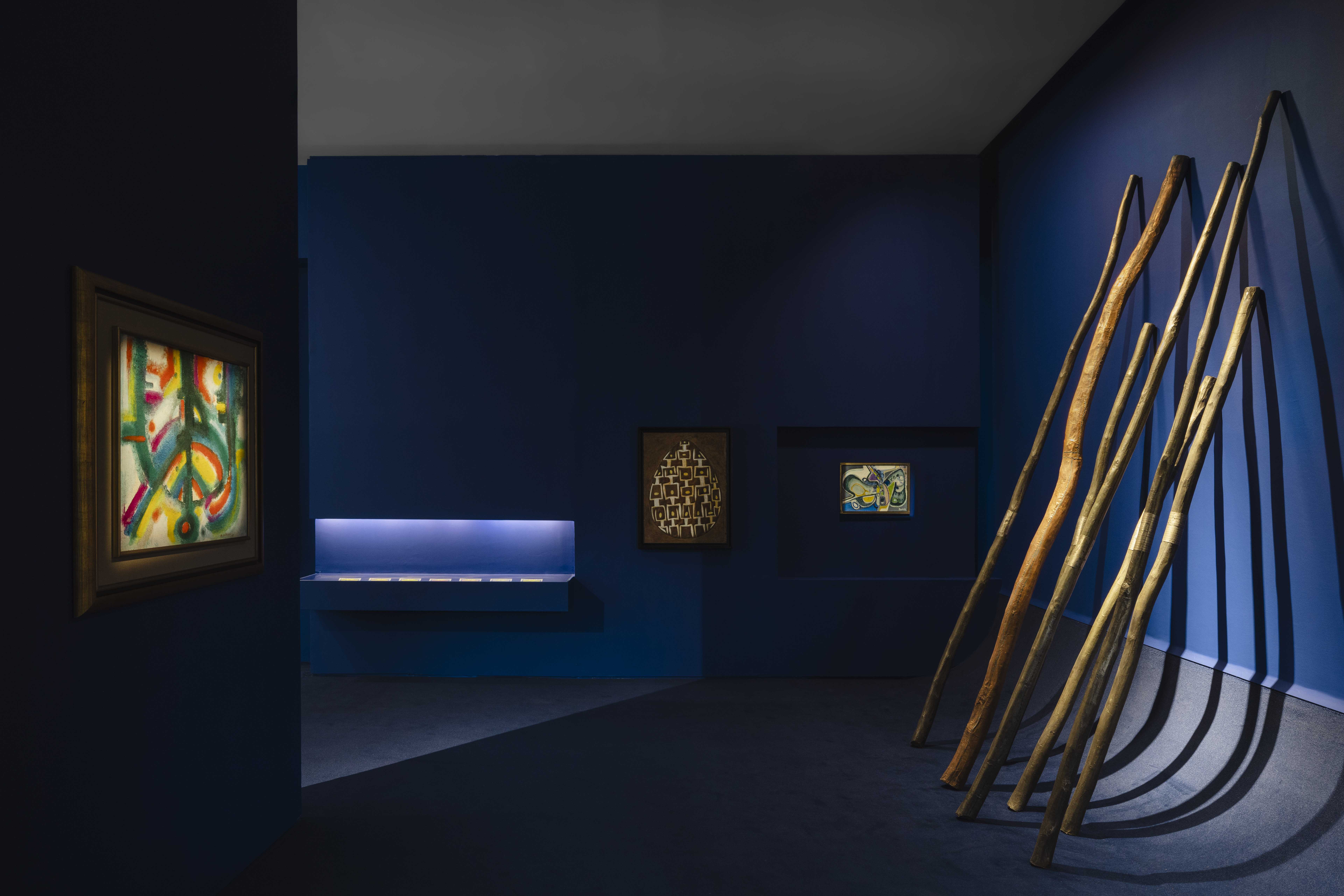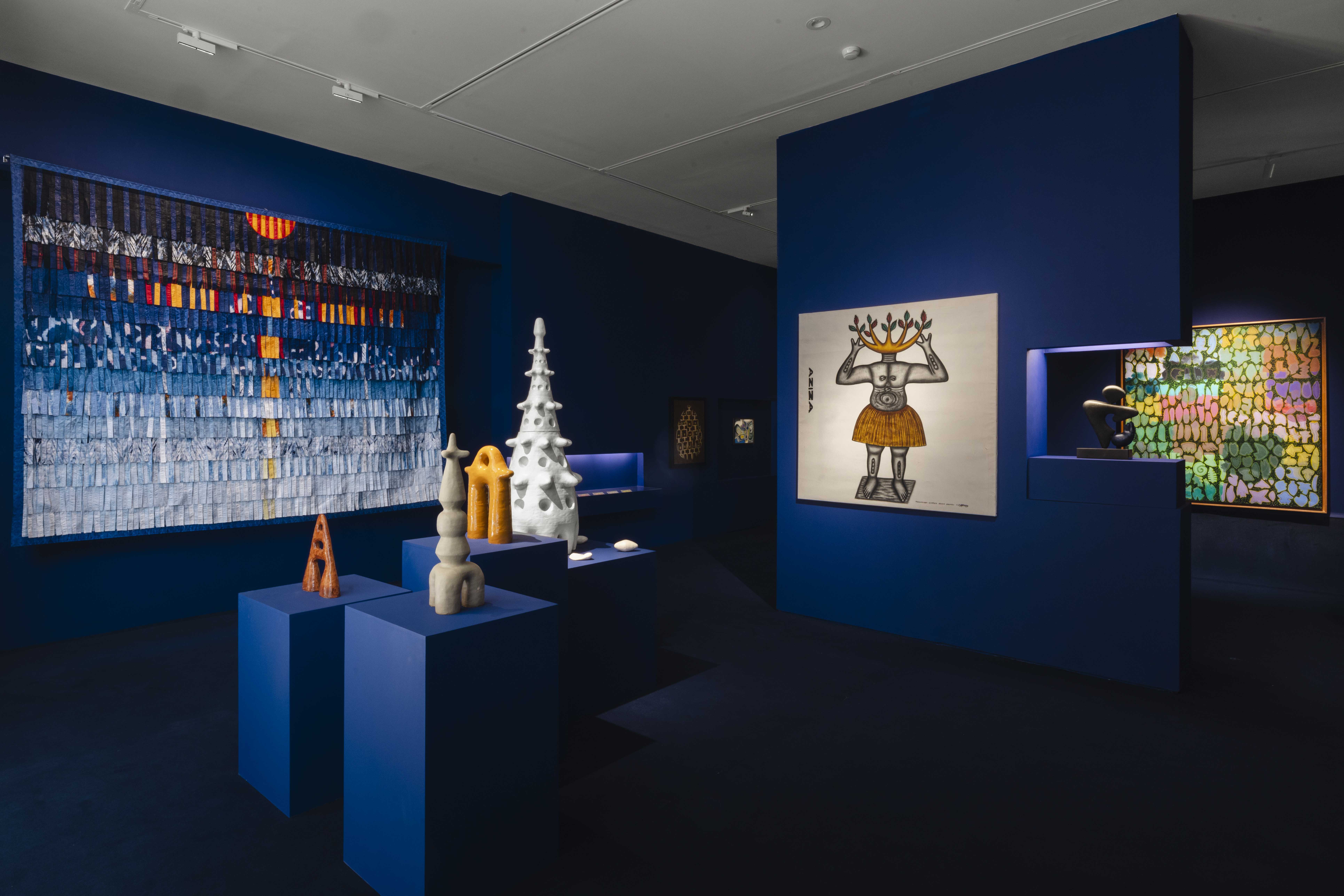لطالما اهتم الفنانون الحديثون والمعاصرون بالرموز، النقوش، الأبجديات، واللغات، سواء كانت حقيقية أو متخيلة. فالرموز المكتوبة – مثل الصور الرمزية، الإيدوجرامات، الهيروغليفية، تقطيع الكلمات، والآيات المقدسة وغيرها – تعكس التاريخ العريق للقارة الإفريقية الممتد لآلاف السنين. يعمل الفنانون، كعلماء آثار أو كُتّاب، على إعادة تفسير هذه الأنظمة الرمزية، ويكشفون من خلالها عن أشكال متنوعة من العلاقة بالتاريخ، بالمجتمع، وبالهوية.
Modern and contemporary artists have long been interested in signs, motifs, alphabets, and real or imagined languages. Written signs–pictograms, ideograms, hieroglyphs, syllabaries, sacred verses, and more–catalyse the millennia-long history of the African continent. Like archaeologists or scribes reinterpreting these systems of signs, artists reveal through them various forms of relationship to history, community, and identity.
مقابلة مع الناقد الفني والقيّم فرانك هيرمان إيكرا
Interview with art critic and curator Franck Hermann Ekra
فرانك هيرمان إكرا، ناقد فني وقيّم معارض، يتعاون مع العديد من الفنانين من دول مثل السنغال، ساحل العاج، وبنين، الذين يمتلكون قدرة على استحضار كتابات بصرية مقدسة أو دنيوية. يتجاوز إكرا "مدارس الرموز" المختلفة ليبرز كيف يعمل الفنانون على الحفاظ على الرموز وتنقلها بين الأماكن، سواء كانت هذه الرموز قديمة أو مهددة بالزوال. يُلفت انتباهنا إلى تاريخ بصري وعابر لإفريقيا يتعلق بالكتابة، في مساحة تتراوح بين فك الشفرات، الترجمة، ونقل النصوص.
Art critic and curator Franck Hermann Ekra collaborates with numerous artists from Senegal, Ivory Coast and Benin, who possess the power to evoke both sacred and secular visual writings. Beyond the different "schools of signs," he illustrates how artists work towards the survival and nomadism of signs–sometimes ancient or endangered. He raises awareness of a trans-African visual history of writing that encompasses deciphering, translating, and transcribing.

امبارك بوحشيشي - المغرب، 1975
M'barek Bouhchichi (Morocco, 1975)
يتبنى امبارك بوحشيشي ممارسة فنية متعددة التخصصات، حيث يجرب بمجموعة مفتوحة من الأشكال والمواد يسعى من خلالها إلى طرح تساؤلات وخلق مزيج جديد – سواء من خلال هجرة العلامات أو المهارات الحرفية. تقترب ممارسته من مادية مفاهيمية تهدف إلى استكشاف استراتيجيات إعادة تأهيل الثقافة الأفرو-أمازيغية وتداولها، بما في ذلك أشكالها غير المادية. وغالبًا ما تركز أعماله على تكريم وإعادة الكرامة للمجتمعات المهمشة التي عانت من مصادرة أراضيها ومن العنصرية. إنه وضع شعوب الصحراء (الطوارق، الفولاني...) التي هي ضحية السياسات الاقتصادية النيوكولونيالية والاستحواذ على مواردها الطبيعية. يحيل عنوان التركيب الفني "إمديازن (الشعراء)" الذي يتألف من 7 عصي، إلى مؤسسة الشعراء والممثلين الجوالين المنتشرين في المناطق القروية الناطقة بـ "التمزيغت"، وهي إحدى اللغات البربرية الثلاث المتحدث بها في المغرب. العصي، التي تعد في آنٍ واحد قطعًا منحوتة وأدوات أدائية، موضوعة بشكل عمودي ومستندة إلى الحائط. وهي مكونة من خشب مغطى بأوراق النحاس، وعلى سطحها منحوتة مقاطع من قصائد امبارك بن زيدا (1925-1973)، وجد فيها الفنان ذاته ومصدر إلهامه. هذا العمل هو تكريم من فنان تشكيلي لشاعر نحت رموز ثقافة أمازيغية مقموعة من قبل الثقافة العربية السائدة، وهي ثقافة مُنعت أبجديتها الأمازيغية لفترة طويلة. العصي المنتصبة أمامنا تُعد مواد-شهادات بانتظار آخر الرواة الذين سيجرؤون على ترديد تلك الكلمات المنحوتة في الساحات العامة.
M’barek Bouhchichi cultivates an interdisciplinary artistic practice, experimenting with an open repertory of forms and materials that he uses to question and combine; migrating signs and symbols as well as skill. He embraces conceptual materialism in his process, exploring strategies for the rehabilitation and circulation of Afro-Amazigh culture both tangible and intangible, often paying tribute to the dignity of marginalised communities that have been victims of racism and expropriation. Groups like Saharan peoples (Tuaregs, Peuls, and others), under the yoke of neo-colonial economic policies and the capture of natural resources. The installation of 7 staffs, entitled Imdyazen (Poets), refers to the ensemble of itinerant poets and actors based in rural areas who speak Tamazight, one of the three Berber languages spoken in Morocco. The staffs–standing vertically, leaning against a wall–are sculptural yet performative objects, made of wood covered in sheets of copper. Carved onto the metal’s surface are fragments of poems by M’barek Ben Zida (1925-1973), oral compositions in which M’barek Bouhchichi recognizes himself. A tribute from a visual artist to a poet who has come to engrave the signs of an Amazigh culture long oppressed–to the point of banning the alphabet–by a dominant Arab culture. The sticks that stand before us are witness-objects waiting for the last storytellers ready to chant these etched words out loud in the public square.
الفنانون المعروضون
Exhibited Artists
محمد رومان عطالله، مبارك بوحشيشي، فريدريك برولي بوابري، أحمد الشرقاوي، صلاح المر، الجيلالي الغرباوي، محمد حميدي، عيسى إيكن، عبد الله كوناتي، ميلود لبيض، سارة أوحدو، بن أوركين، عبد الكبير ربيع، عبد الرزاق الساحلي، سيبريان توكوداغبا
Mohamed Romain Ataallah, M'Barek Bouhchichi, Frederic Bruly Bouabre, Ahmed Cherkaoui, Salah Elmur, Jilali Gharbaoui, Mohamed Hamidi, Aissa Ikken, Abdoulaye Konaté, Miloud Labied, Sara Ouhaddou, Ben Orkin, Abdelkebir Rabi, Abderazak Sahli, Cyprien Tokoudagba


